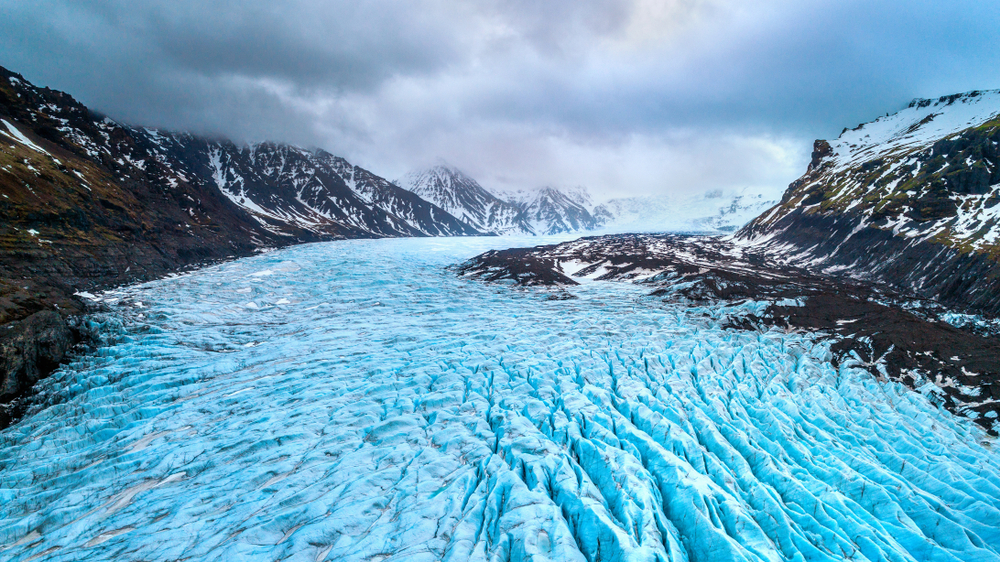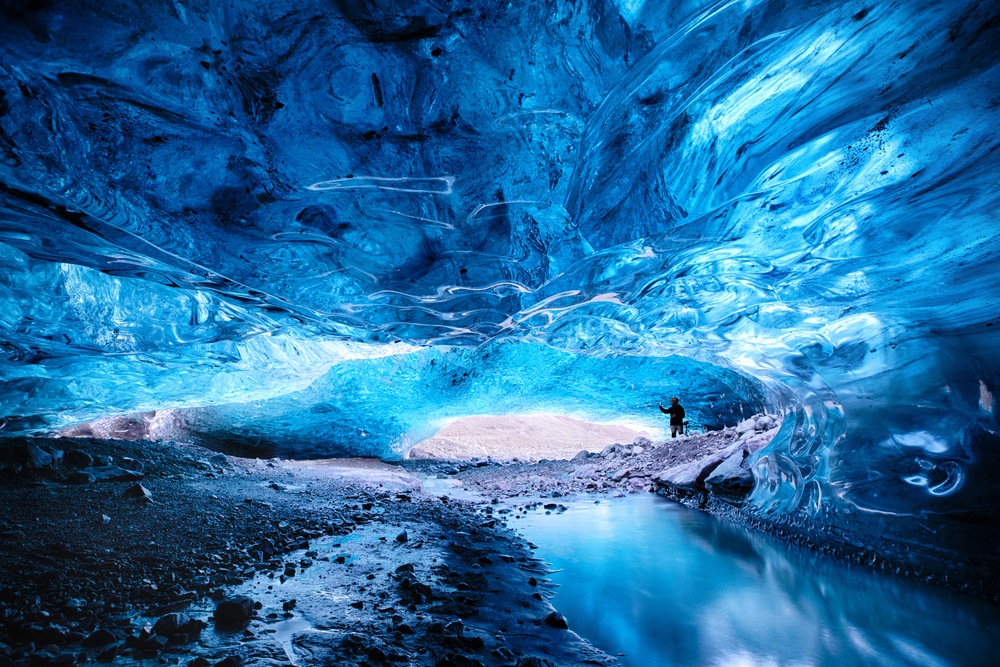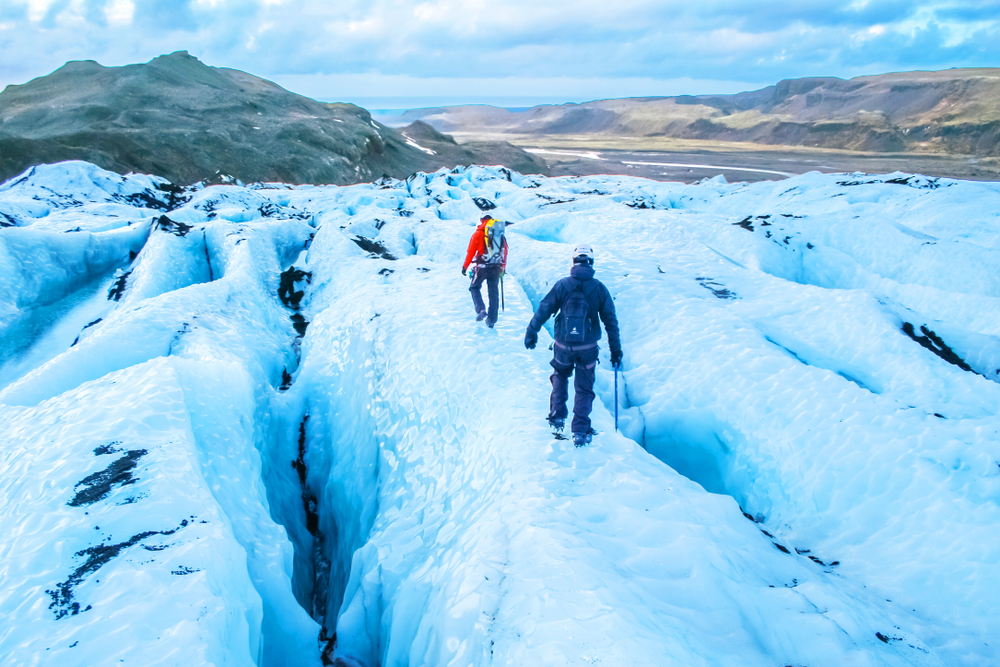Iceland, sometimes called the “land of ice and fire”, has some truly epic scenery. Its volcanic peaks and lava fields sit alongside its expansive frozen glaciers, producing dramatic and fantasy-like terrain, but these glaciers aren't just picturesque backdrops! In this article, we’ll explore how these frozen landscapes are formed over time and learn about the various types of glaciers scattered across this Nordic region.
Jump to:

What are Glaciers?
A glacier is a massive, persistent body of ice that forms when snow accumulates over time, undergoes compaction and transforms into ice.
The primary characteristic of a glacier is its ability to accumulate more ice or snow during the winter than it loses during the summer. This continuous accumulation, known as “glacier mass balance”, results in the glacier's growth.
You may not have thought about it, but glaciers are not static - they move (albeit very slowly)! Under the influence of gravity, glaciers flow downhill over time, shaping the landscape as they go. Unlike other ice formations, glaciers are also permanent ice; they persist over extended periods, sometimes for centuries or even millennia.
In terms of ice composition and density, the ice in glaciers isn’t like the ice you’d find in your freezer; it has a distinct composition. Glacial ice is formed from the compaction of snow. Over time, the weight of accumulating snow presses down on the underlying layers, causing the snowflakes to recrystallise into a denser form of ice known as “firn”.
With further compression, firn eventually becomes glacial ice. Interestingly, this ice usually appears to be blue. This phenomenon is caused by the ice absorbing longer-wavelength red and yellow light, leaving the shorter-wavelength blue light scattered and reflected.
Recommended for you!
Best SellersHow are Glaciers Formed?
The process starts with the accumulation of snow. Snowfall can be substantial in high mountain ranges or polar areas, especially during the winter months. As more snow falls and accumulates, the weight of the overlying snow compresses the layers beneath it. Over time, this compaction forces the snowflakes to recrystallise, transforming them into firn: a dense, granular snow. With continued snowfall and further compression, the firn gradually evolves into solid glacial ice. Depending on the snow accumulation rate, this transformation typically takes several decades or even centuries. Once the ice mass attains sufficient thickness, it begins to exhibit the defining characteristic of glaciers—slow, downhill movement under the influence of gravity.
Several key factors contribute to the formation of glaciers:
- Cold Climate: Glaciers require a climate with cold temperatures, particularly in regions where annual snowfall exceeds snowmelt. This is why glaciers are more commonly found near the poles or at high altitudes.
- Sufficient Precipitation: Adequate snowfall is essential for accumulating snow and ice. Regions with heavy and consistent snowfall are more likely to support glacier formation.
- Topography: The landscape's topography plays a significant role. Steep, mountainous terrain provides the necessary conditions for accumulating and preserving snow and ice.
- Glacial Mass Balance: For glaciers to form and persist, they must maintain a positive mass balance. This means that the rate of ice accumulation (from snowfall and other sources) must exceed the rate of ice loss (from melting, sublimation, and calving).
Iceland’s geographical features make it the perfect setting for glacier formation. Situated along the Mid-Atlantic Ridge, the island experiences significant volcanic activity, resulting in topographical features ideal for glacier formation.
The central highlands of Iceland offer extensive areas with the perfect combination of elevation and cold climate, and its northern latitude ensures consistent snowfall (particularly during the winter months), contributing to glacier growth. Additionally, Iceland's proximity to the Arctic Circle leads to extended periods of cold weather, which is instrumental to the maintenance and longevity of these frozen wonders.

Glaciers in Iceland
The glaciers in Iceland, ranging from small ice caps to massive icefields, cover around 11% of the country’s total land mass and represent the 11th largest glacier area worldwide!
However, beyond their majestic appearance, glaciers hold a special place in Icelandic culture. Icelanders have a rich storytelling tradition; some legends feature glaciers as key elements. Many glacier names in Iceland have their origins in these ancient stories!
Glaciers also play a crucial role in the sustainable freshwater supply of the country. They feed Iceland's rivers and contribute to freshwater resources as they melt. Icelanders have harnessed this glacial water for hydroelectric power generation and use it to produce some of the purest drinking water in the world.
However, as climate change threatens the existence of many of these Icelandic glaciers, glacial research and conservation efforts have become critical aspects of Iceland's commitment to preserving its natural landscape.
Notable Glaciers in Iceland
- Vatnajökull
Vatnajökull, known as “The Water Glacier”, is Europe’s largest glacier. It spans over 8,100 square kilometres in southeastern Iceland at Vatnajökull National Park, a UNESCO World Heritage site. This glacier is renowned for its ethereal ice caves within its depths. It also has beautiful glacial lagoons, such as Jökulsárlón and Fjallsárlón, that are hugely popular for boat tours. Vatnajökull is so vast that it feeds numerous outlet glaciers, each with distinctive features. Skaftafellsjökull, Svínafellsjökull, and Breiðamerkurjökull are just a few examples of these outlets.
- Langjökull
Langjökull, which translates to “Long Glaciers”, is Iceland's second-largest glacier and is situated in the western part of the country. It’s easily accessible from Reykjavik, making it a popular tourist destination. Langjökull is known to be a prime location for snowmobile tours, allowing visitors to glide across the glacier's icy expanse while enjoying breathtaking panoramic views of the surrounding landscape. Beneath the surface of this glacier is a network of manufactured ice tunnels, created to offer visitors a surreal glimpse into the glacier’s core.
- Snæfellsjökull
Located on the Snæfellsnes Peninsula in western Iceland, Snæfellsjökull is a glacier-capped stratovolcano (a conical volcano built up by many layers of hardened lava and volcanic ash) and is famously known as the setting for Jules Verne's classic novel, "Journey to the Center of the Earth”. Its snow-capped peak rises 1,446 metres (4,744 feet) above sea level, making it one of the most prominent landmarks on the Snæfellsnes Peninsula. In Icelandic folklore, it’s also considered to be one of the country's most spiritually significant sites and has inspired artists and poets for centuries.
- Hofsjökull
Hofsjökull is nestled in the central Highlands of Iceland and is a massive ice cap that serves as the source for several prominent rivers in Iceland, including Þjórsá, one of Iceland's longest rivers. Because of its remote location in the Highlands, it remains relatively untouched and symbolises the landscape's natural beauty. Its name, “Hofsjökull”, also translates to “Temple Glacier”, which is a fitting title for this glacier which lives in peace and isolation.

Types of Glaciers in Iceland
Glaciers are classified based on several factors, including their size, location, and characteristics. There are many subtypes, but they can generally be categorised into two main groups: Mountain glaciers and Continental glaciers.
Mountain glaciers are typically found in mountainous regions within valleys and tend to be much smaller than continental glaciers. They’re also often influenced by the local topography. They can be further divided into cirque glaciers, valley glaciers, and piedmont glaciers.
Continental glaciers, also known as “ice sheets” or “ice caps, " are massive ice expanses covering entire land masses. The two largest continental glaciers on Earth are the Antarctic Ice Sheet and the Greenland Ice Sheet.
Iceland hosts a variety of glacier types, mainly due to the country’s unique geography and climate. The most prominent types of glaciers in Iceland include:
- Ice Caps - Iceland has several ice caps, including Vatnajökull, Langjökull, and Hofsjökull. These are extensive ice masses that are typically dome-shaped and cover the summit of a mountain or volcano.
- Outlet Glaciers - These glaciers flow from ice caps or ice sheets, draining into lower-lying areas. Vatnajökull, for instance, has numerous outlet glaciers, such as Breiðamerkurjökull, which extends into the Jökulsárlón glacial lagoon.
- Cirque Glaciers - These are small, bowl-shaped glaciers found in the cirques, or hollows, on the sides of mountains. The Snæfellsjökull glacier in western Iceland is a classic example of a cirque glacier.
- Tidewater Glaciers - These glaciers terminate in the sea, where ice meets the ocean waters. Although they’re not as common in Iceland as in some other regions, there are tidewater glaciers in the country, contributing to the formation of icebergs in glacial lagoons.
- Plateau Glaciers - Plateau glaciers are found in Iceland's central highlands and are characterised by their relatively flat, expansive ice surfaces.
- Alpine Glaciers - These glaciers occupy steep-sided valleys in mountainous regions, adapting to the local topography. Many of Iceland's mountain glaciers are considered alpine glaciers.
How do Glaciers Move?
As mentioned earlier, glaciers are not static and are constantly moving. But why is this?
Glaciers are under the continuous influence of gravity, which pulls them downhill. This force compels the glacier to flow like a frozen river, albeit much slower. The glacial ice itself - formed under immense internal pressure - accumulates, and as the weight from the above layers increases, it creates a downward force that causes the ice to deform and flow. In addition, basal slip is one of the primary mechanisms of glacier movement. This occurs when the glacier's base (in contact with the underlying bedrock or sediments) melts due to pressure and temperature. The resulting water allows the glacier to slide over the ground.
5 Interesting Facts about Glaciers
- Glaciers cover about 10% of the Earth's land area and are found on every continent (including Antarctica, where they make up the largest portion).
- Glaciers hold approximately 68.7% of the world's freshwater, making them one of the largest repositories of freshwater on the planet!
- Glacial ice can be thousands of years old. Some ice at the centre of Antarctica is estimated to be over 800,000 years old!
- Glaciers are in constant motion, although at an incredibly slow pace. The pull of gravity drives their movement and can be as slow as a few centimetres per day.
- Some glaciers are enormous rivers of ice. For example, the Lambert Glacier in Antarctica is the world's largest glacier, stretching over 60 miles wide and 250 miles long.
If you're eager to continue exploring the fascinating field of Earth Sciences, don't miss the opportunity to check out our accredited Earth Science Diploma Course. With a dedicated module on glaciology, you can take your knowledge to the next level. Enrol now for just £37 (save £110!)!













